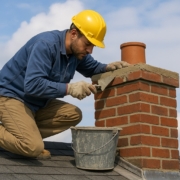How to Spot Early Signs of Chimney Repair in Tucson
If you call Tucson home, you know that owning a fireplace can make those chilly desert nights extra cozy. But what many folks don’t realize is that the dry heat, those sudden monsoon storms, and everyday use can team up to wear down your chimney over time. Catching trouble before it gets serious is much easier than you’d think—and way less expensive than waiting until the damage is staring you in the face. Today, let’s break down how to play detective and catch the early signs that your chimney might need a little TLC, especially when it comes to chimney repair.
Listen to Your Chimney’s Story
Chimneys may not talk, but they do send signals when something’s off. It could be a strange sound, a new crack, or even a weird smell. The trick is to notice what’s different from the usual. For starters, take a moment every now and then to look up at your chimney from outside. If you see pieces of brick or mortar on the ground, that’s your first clue. Indoors, odd drafts or a musty scent can also hint that something’s up. Trust your senses—the nose, eyes, and ears all help when it comes to spotting early problems.
What Does Tucson’s Weather Do to Chimneys?
Living in Tucson means dealing with a lot of sun and the occasional wild rainstorm. That mix can be tough on brick and mortar. The hot sun can dry things out and create small cracks, while storms can sneak water into those cracks, making them bigger over time. If you notice white stains (called “efflorescence”) or dark, damp patches on your chimney, that’s a sign that moisture is getting in where it shouldn’t. And since Tucson isn’t exactly famous for gentle weather, these issues can pop up faster than you’d expect!
| Sign | What It Might Mean | What To Do |
|---|---|---|
| Cracked Bricks or Mortar | Weather or age has weakened your chimney’s exterior. | Schedule a professional inspection soon. |
| White Powdery Stains | Moisture is seeping through and leaving mineral deposits. | Check for leaks and waterproof if needed. |
| Musty or Smoky Odor Indoors | Possible water damage or blockages inside the chimney. | Have the chimney cleaned and checked. |
| Pieces of Brick on the Ground | Spalling, meaning the brick surface is flaking off. | Repair loose bricks before the damage spreads. |
Inside Clues: What’s Your Fireplace Telling You?
Sometimes, the hints are right where you sit. If you notice bits of brick, mortar, or even soot building up at the bottom of your fireplace, that’s a sign that things are falling apart up above. Pay attention to how smoke travels—if it backs up into your living room or seems to struggle leaving the chimney, there could be a blockage or structural issue. Strange sounds, like birds or critters inside, are another red flag. Tucson’s wildlife loves a good hideout, so if you hear rustling, it’s time for a closer look.
DIY Checks You Can Do (No Ladder Needed!)
You don’t need to be a chimney sweep to catch early warning signs. Once in a while, take a flashlight and look up into your fireplace. Check for loose bricks, crumbling mortar, or any buildup of soot. Sniff around for new, strong odors. From outside, even just glancing at your chimney’s shape can help—if it’s leaning or looks uneven, that’s a sign it needs attention. Catching these little things early can save you a lot of hassle and money down the road.
“Chimneys don’t fall apart overnight—they whisper their troubles before they shout. Listen early, and you’ll save yourself a heap of worry and cash.”
– Local Tucson Chimney Pro
FAQs about Chimney Damage in Tucson
Q: How often should I check my chimney for problems?
A: At least once every few months, especially after a big storm or before you start using your fireplace for the season.
Q: Can the Tucson sun really hurt my chimney?
A: Absolutely! The sun can dry out the mortar and create cracks that grow over time.
Q: What if I spot a crack but my chimney seems fine otherwise?
A: Even small cracks can turn into bigger issues. It’s smart to call a chimney professional before things get worse.
Q: Do I need to stop using my fireplace if I suspect damage?
A: If you notice signs like smoke backing up, loose bricks, or strong odors, hold off on using your fireplace until a pro can take a look.
Wrapping Up
Keeping your chimney in good shape in Tucson doesn’t have to be a mystery. A little attention goes a long way—just look, listen, and trust your instincts. Catching problems early means less stress and a safer, warmer home. If you do spot something that seems off, don’t wait—reach out to a chimney repair expert who knows the ins and outs of Tucson’s weather. Your cozy nights by the fire will thank you!
Read More: Tucson Chimney Sweep


